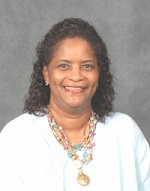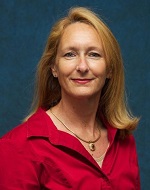Apply now to join our next cohort of Community Science Fellows and Community Leads!

Project Title: Assessing Flood Risks for Community-Led Action
Location: Gulfport, MS
The Team:
The goal of this project was to bring objective scientific evidence and understanding to the questions and priorities of residents around flooding and air quality, so the community can use that science to make decisions and take action alongside elected officials.
The project team began their collaboration via an in-person meeting to engage with and listen to residents and to visit and discuss key areas of concern in the community. This meeting helped the team plan the scope of their engagement and identify key collaborative opportunities to extend the impact of their work – particularly the Land Trust and local high school.
Coming out of the meeting, it was apparent to the project team that residents were excited by education and awareness opportunities and eager to learn more about the nuances and science behind local environment and environmental impacts. Therefore they organized a series of six educational workshops centering on three themes: the built environment, wetlands, and sea level rise. Each of the themes was presented in two workshops: one oriented toward high school students, and the other to adult members of the community.
Katherine, with the support of local partners, took responsibility for organizing the workshops. This included securing a time and location for each, inviting residents, preparing flyers, coordinating with the local high school – including securing buses for the wetlands workshops – ordering food, and sharing about the event with local media.
Each of the scientific partners (Chris, Gianna and Renee) prepared and delivered a hands-on educational workshop aligned with their expertise and responsive to the questions and priorities voiced during the initial meeting.
The team met remotely via Zoom video chats before and after each workshop to coordinate logistics and debrief on successes and lessons learned.
Engineering with Nature – September 17

Community members examining Gianna’s porous concrete demonstration
These workshops explored engineering terms and practices associated with urban design and flood mitigation. Topics included gray vs. green infrastructure, design storms, the basis for calculating run-off estimates, impervious surfaces, and upstream-downstream impacts. Examples featured included local features like the outlet mall and shed light on the functionality of a local stormwater detention pond. The presentations also included a physical demonstration of porous concrete constructed in Gianna’s kitchen.*
The high school workshop was attended by 40 students; 15 adults attended the evening workshop.
The Importance of Wetlands – October 4/5
These workshops included an “in-classroom” lecture on wetlands (what they are, types of local wetlands, and benefits to the community) and a field trip to tour local wetland sites. During the field trips, Chris shared about flood plains and their connections to the creek, intersections between environment and society. They also visited an area of active wetland restoration (from a wooded landscape to the native (and rare) wet pine savanna). This was an opportunity to address community concerns about wetland function and restoration activities, including whether tree removal would exacerbate flooding. (The answer in this case was probably not.) Nick Goyette and Judy Steckler with the Land Trust for the Mississippi Coastal Plain, were present to provide local scientific insights and details about the restoration project.
The high school workshop was attended by 41 students (lecture) and 35 students (field trip); 20 adults attended the Saturday lecture/field trip.

Sonia Vedral (Northern Gulf of Mexico Sentinel Site Cooperative) presenting pre-test answers collected through Poll Everywhere to the high school students at the sea-level rise session. Credit: Renee Collini, Northern Gulf of Mexico Sentinel Site Cooperative
Introduction to Sea Level Rise – October 22
Content for the high school workshop included a brief lecture on sea level rise, and several hands-on activities showcasing:
Renee and her colleagues shared a pre- and post-test with students asking questions about sea level rise and climate change. Before the workshop, the majority of students got no questions correct. After the workshop, the majority got ALL of the questions right.
The community workshop provided opportunity for residents to learn about and ask questions about sea level rise. The workshop featured open Q&A and videos followed by discussion. One video featured a case study about how a community worked to integrate local knowledge with scientific methods to get a better picture of flooding around the region.
The high school workshop was attended by 40 students; 20 adults attended the community meeting.
These workshops were designed to be responsive to community interests and questions, with content presented in an informal, interactive and, most importantly, relatable manner. As a result, this project generated interest and engagement among community members around their community and local environment. Features like the local wetlands that residents would drive past without thought are now notable elements of the community with a known and understood function.
Residents of Gulfport – both students and adults – are more aware of the value of wetlands and how natural and manmade systems intersect. Not only do they know more about these topics, but they are excited by them and their relationships to their daily lives. Understanding what’s going on in their community and how it works helps contextualize local development activity and aids community members in responding to local planning decisions and environmental concerns.
For EEECHO: Several residents have reached out to Katherine wanting to learn how to join and get more involved with EEECHO. The organization will also be carrying forward best practices like pre- and post-workshop evaluations to better track effectiveness of activities and collect feedback for continuous improvement.
Things that contributed to success in this project:
Things the team might do differently if they were to do it over again:
Advice for people pursuing similar community science projects:
Media Mentions
WLOX: Gulfport organization takes students out of the class and into nature – 10/5/2019
WLOX: Port of Gulfport’s construction plans on hold after opponents file appeal – 10/24/2019
*Instructions for Porous Concrete Demonstration from Gianna:
 “I used a 3 to 1 ratio of river rock and morter cement that I bought from Home Depot (~1 gal or 9inx12inx2in pan of rock to about 1/3 gal of cement. I took out the larger sized rocks. Add water until you get a good workable consistency. I added about 1/3 gal of water, but it depends on how wet or dry your ingredients are.”
“I used a 3 to 1 ratio of river rock and morter cement that I bought from Home Depot (~1 gal or 9inx12inx2in pan of rock to about 1/3 gal of cement. I took out the larger sized rocks. Add water until you get a good workable consistency. I added about 1/3 gal of water, but it depends on how wet or dry your ingredients are.”
Gulfport, the second-largest city in Mississippi, and surrounding areas have faced many natural disasters since the landfall of Hurricane Camille in 1969 to the devastation caused by Hurricane Katrina in 2005, but the inherent resilience of its citizens to rebuild and endure continue to keep the spirited community coming back. However, a lack of adequate drainage (open a closed ditches) to complement the revitalization and development efforts within the coastal area of the city creates large flooding events following short rain periods. The recent reduction in wetlands regulation, zoning changes, industrial development, and the expansion of impervious surfaces as citizens move north from the beachfront has further exacerbated these localized flooding issues. This creates flooding issues along the interstate, with subdivisions to the south of I-10 facing the most severe impacts, specifically the historically significant communities of Turkey Creek (one of the first settlements established by emancipated African Americans) and Forest Heights (one of the nation’s first integrated home ownership developments for low income families).
Residents in Gulfport neighborhoods are continually facing heavy rains which leads to flooding that often enter houses and yield to constant development without adequate drainage for storm water management. Heavy-use diesel traffic along the 25th St. corridor and stripping roads to dirt for redevelopment in nearby Biloxi has residents concerned about local air quality and associated health concerns. They currently have working relationships with NAACP, US Climate Action Network, HBCUs, and the National Environmental Justice Conference and Training Program.
The goal of this project is to bring objective scientific evidence and understanding to the questions and priorities of residents around flooding and air quality, so the community can use that science to make decisions and take actions alongside elected officials.
This project has been conceived and designed in partnership with community leaders at Education, Economics, Environmental, Climate and Health Organization and with our national partner, Higher Ground.

From Katherine Egland:
Gianna M. Cothren, Renee Collini and Christopher Anderson came out during a rainstorm for an extremely productive meeting with a small community focus group on Friday, August 2 at Forrest Heights Baptist Church, located at the foot of the Turkey Creek Bridge in Gulfport. Residents were eager to be engaged in shoring their history and experiences and left feeling encouraged about the next steps. The group decided that there is a tremendous need for community education and awareness. Education, Economics, Environmental, Climate and Health Organization (EEECHO) and partners plan to host a series of Town Hall Meetings and wetlands site visits culminating in a full day community training. These events will be open to EEECHO’s student partners at Gulfport High, Central Middle and North Gulfport 7th and 8th Grade schools.
(Photo courtesy of Katherine Egland)

Katherine Egland is co-founder of the Education, Economics, Environmental, Climate and Health Organization (EEECHO), a Gulf Coast grassroots coalition of diverse, consensus-based group of educational, economics, health, environmental justice, climate justice, religious, and policy advocates and professionals that represent the interest of building better communities.

Chris Anderson is an Associate Professor at Auburn University. Chris’s research examines the effects of human activities on a wide range of aquatic and riparian ecosystems. His goal is to understand how these disturbances change ecosystem function and how these alterations may be mitigated. He is particularly interested in results that influence regulations, environmental models, and planning which guide land use and natural resource policy.
Chris is also Associate Director for the Auburn University Center for Environmental Studies at the Urban-Rural Interface. The Center supports interdisciplinary research, outreach, and education related to urban land use change. Chris holds a Ph.D. in natural resources from Ohio State University.

Gianna Cothren is an Associate professor in Civil & Environmental Engineering at the University of New Orleans with expertise in Coastal Restoration Sustainability & Environmentalism. Her research interests include Urban and rural environmental hydrology; Hydrologic modelling; Geographic Information System (GIS) applications in water resources; and Physical, chemical, and biological wetland functions. Gianna holds a Ph.D. in Civil and Environmental Engineering from Louisiana State University.

Renee Collini is the Northern Gulf of Mexico Sentinel Site Cooperative Coordinator at the Mississippi-Alabama Sea Grant Consortium. Renee works with scientists who are monitoring and collecting data at sanctuaries, estuarine research reserves, marine protected areas and other locations across the Gulf of Mexico (from the Pearl River at the Louisiana-Mississippi state line to the Suwanee River in the Florida Panhandle). She also works with researchers, managers, decision makers and other stakeholders in an outreach role to identify informational gaps and needs in the region. She holds a master’s degree in marine science from University of South Alabama.
Thriving Earth Exchange has partnered with Higher Ground which supports grassroots flood groups across the country by helping them develop strategies for a sustainable future. Thriving Earth Exchange is working with their grassroots groups to connect them with scientists who can help them better characterize neighborhood-level flood risks and work effectively with local decision makers to mitigate those risks.

(c) 2024 Thriving Earth Exchange